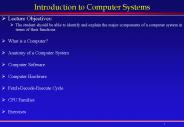Introduction to Computer Programming - PowerPoint PPT Presentation
Title:
Introduction to Computer Programming
Description:
Title: Introduction to Computer Programming Subject: Looping Around Loops I: Counting Loops Author: Robert M. Siegfried Last modified by: Kristin Pepper – PowerPoint PPT presentation
Number of Views:51
Avg rating:3.0/5.0
Title: Introduction to Computer Programming
1
Introduction to Computer Programming
- Error Handling
2
What to do with errors?
- Return something the caller will understand
- Public static int myMethod(int x)
- if (x lt 0) return -1
- else do what you want the method to do
- Throw Exception
- Public static int myMethod(int x)
- if (x lt 0)
- throw new IllegalArgumentException(x is
negative and must be 0 or greater) - else do what you want the method to do
3
What is an Exception?
- Java has objects called Exceptions that carry
information about errors. - IllegalArgumentException is one type
- When code throws an exception, it stops
processing the method without a proper return. - When an exception is a Checked type, it also
stops the program from running if noone deals
with it.
4
Make an Exception Happen
- import java.util.Scanner
- public class Scan
- public static int getNumb()
- Scanner rdr new Scanner(System.in)
- System.out.println("Enter a number from 1 to
10") - int entry rdr.nextInt()
- return entry
5
What happens to the calling program when an
Exception happens?
- If the caller does not handle it
- Crash
- Like your Scanner programs that received letters
instead of numbers - If the caller handles it
- Does not crash
- Does not look at return value
6
How to code Exception Handling
- Try/Catch block
- public static void main()
- int x
- try
- x getNumb()
- catch (Exception e)
- System.out.println("X was never
filled") - System.out.println("Every line will print
here")
7
You Try a Try/Catch Block
- Given this method
- public static int times6(int x)
- if (x lt 0)
- throw new IllegalArgumentException(x "is
negative and must be 0 or greater") - else return 6 x
- Code a caller method that takes in 1 number and
uses it to call times6. - When the method times6 returns normally, print
the returned number. - When the method times6 throws an exception, print
oops! - Always print The End
8
Answer to Try/Catch practice
- public static void caller (int a)
- try
- int y times6(a)
- System.out.println(y)
- catch (Exception e)
- System.out.println("oops!")
- System.out.println("goodbye")
9
Getting the message back
- When you receive an exception
- Get the message text with
- Exception object . getmessage()
- Example
- catch (IllegalArgumentException e)
- System.out.println("oops!"
e.getMessage())
10
Checking Types
- You can throw different types of exceptions
- Test them in order using elseif logic
- catch (IllegalArgumentException e)
- System.out.println("oops!"
e.getMessage()) - catch(Exception e)
- System.out.println("oops2 ")
11
Summary
- You can stop executing a method with a throw
command. - Create an exception to throw new
IllegalArgumentException(tell about the error) - You can catch the error in the calling program
using a try /catch block. - Try
- Catch































